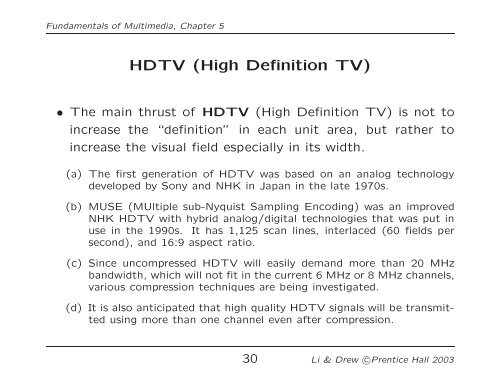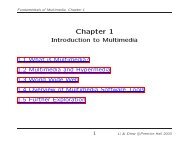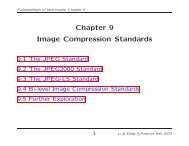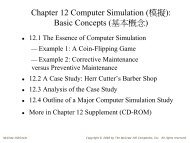Fundamental Concepts in Video
Fundamental Concepts in Video
Fundamental Concepts in Video
Create successful ePaper yourself
Turn your PDF publications into a flip-book with our unique Google optimized e-Paper software.
<strong>Fundamental</strong>s of Multimedia, Chapter 5<br />
HDTV (High Def<strong>in</strong>ition TV)<br />
• The ma<strong>in</strong> thrust of HDTV (High Def<strong>in</strong>ition TV) is not to<br />
<strong>in</strong>crease the “def<strong>in</strong>ition” <strong>in</strong> each unit area, but rather to<br />
<strong>in</strong>crease the visual field especially <strong>in</strong> its width.<br />
(a) The first generation of HDTV was based on an analog technology<br />
developed by Sony and NHK <strong>in</strong> Japan <strong>in</strong> the late 1970s.<br />
(b) MUSE (MUltiple sub-Nyquist Sampl<strong>in</strong>g Encod<strong>in</strong>g) was an improved<br />
NHK HDTV with hybrid analog/digital technologies that was put <strong>in</strong><br />
use <strong>in</strong> the 1990s. It has 1,125 scan l<strong>in</strong>es, <strong>in</strong>terlaced (60 fields per<br />
second), and 16:9 aspect ratio.<br />
(c) S<strong>in</strong>ce uncompressed HDTV will easily demand more than 20 MHz<br />
bandwidth, which will not fit <strong>in</strong> the current 6 MHz or 8 MHz channels,<br />
various compression techniques are be<strong>in</strong>g <strong>in</strong>vestigated.<br />
(d) It is also anticipated that high quality HDTV signals will be transmitted<br />
us<strong>in</strong>g more than one channel even after compression.<br />
30 Li & Drew c○Prentice Hall 2003












